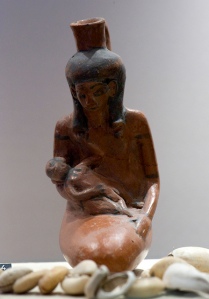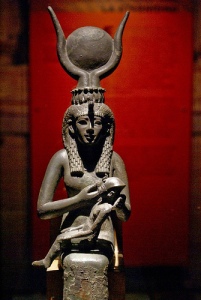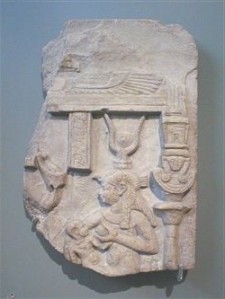Just a note of joy before we start this post: Ahhhhhhhh. Many blessings to those who worked magic, who worked their butts off organizing, calling, and writing, and who worked their powerful, worldly magic by voting. Many thanks to our Divine Ones Who inspired and watched over us. We have a chance again.
And now back to our regularly scheduled post…
You may recall that, to the ancient Egyptians, bodily fluids could be a way of moving magic or heka. Written spells could be licked from the papyrus in order to be taken into the human body. Magic could be eaten or swallowed. Human beings know, deep in our bones, the magic and life-power of both blood and semen.
Multiply the power of these magic-containing fluids to the nth degree when it comes to the Deities. Atum created His children, Shu and Tefnut, by spitting (or ejaculating in His hand in another version). The tears of Re created human beings. The tiet, the Knot or Blood of Isis, protects the dead in the Otherworld.
Yet of all these magical bodily fluids, it may be that milk, especially divine milk, is the queen of them all. To us at least, milk is the most pleasant—and palatable—of the magical body fluids. It is, after all, our first food. In fact, it is the perfect food and it gives us an intimate connection with our mothers. Children nursing at the breasts of their mothers are drinking Life Itself. No death has ever touched this pure milk. It comes from the mother alive. It is drunken alive. It becomes part of a living being.
Milk is indeed magic.
As Great Divine Mother and a Cow Goddess, Isis is also the Egyptian Milk Goddess from a very early period. The Pyramid Texts say to the deceased, “Take the breast of your sister Isis the milk-provider.” Throughout Egyptian history, Isis is the mother and nurse of kings. A scholar who as studied the images of Isis Lactans (“Milk-Giving Isis”) observed that the idea that milk from the breast of the Goddess (Isis as well as other Goddesses) not only gives life, but also longevity, salvation, and even divinity is one that exists “in the mentality of the populations of the Delta from the earliest antiquity, and manifests itself in the official imagery of the Pharaohs.” (Tran Tam Tinh, Isis lactans: Corpus des monuments greco-romains d’lsis allaitant Harpocrate, Leiden: Brill, 1971.)
Egyptian art shows the king drinking this holy milk of the Goddess three important times: at birth, at his coronation, and at his rebirth. The symbolism is clear. Goddess milk provides life to the babe, royal power—and perhaps wisdom and a touch of divinity—to the new king, and renewal after death for the deceased king.
A daily ritual conducted in the temples at Thebes, Memphis, and Abydos was designed to confirm the power of the king. Pharaoh (or more likely, his representative) received the sa en ankh, life-energy, from his Divine Father, Amun-Re, by means of magical gestures. Then he received the power of the Goddess from his Divine Mother, Amunet, by means of drinking Her milk. Carved on temple walls, the Goddess invites the king to suckle the milk from both Her breasts. In Hatshepsut’s temple, Hathor’s milk gives the young Pharaoh “life, strength, health.” The Pyramid Texts have Isis bring Her milk to the deceased Pharaoh to assist in his rebirth: “Isis comes, she has her breasts prepared for her son Horus, the victorious.”

But the king wasn’t the only one to benefit from the divine life magic of milk. Milk was also used for healing. The “milk of a woman who has borne a son” was a fairly common ingredient in Egyptian medicines.
Archeologists have recovered a number of small vessels in the shape of a woman pressing her breast to give milk or, as in the case of the vessel shown here, a woman nursing. They were designed to hold human milk, perhaps for making medicine, perhaps for later feeding of a child. The milk of the Divine Mother was also directly invoked for healing. In a formula for the relief of a burn, Isis says that She will extinguish the fire of the burn with Her milk. By applying Goddess-milk to the body of the sufferer, they will be healed and the fire will leave the body. In a New Kingdom myth, the Goddess Hathor uses gazelle’s milk to heal the eyes of Horus, which had been torn out during one of His battles with Set. A spell from the Berlin Magical Papyrus instructs that if one takes milk with honey at sunrise, it “will become something divine in your heart.” Isn’t that just beautiful?
With all its magical properties, milk was common among the supplies buried with the dead and it served as a valuable offering to the Deities. At Isis’ Philae temple, wall carvings attest that milk was offered to all the Deities worshipped there. To help renew Osiris, milk was poured upon His tomb at Biggeh, a small, holy island visible from Philae. Every ten days, Isis Herself was said to have made these libations.
The whiteness of milk also added to its sanctity in the eyes of the ancient Egyptians, for white was a color they associated with purity and joy. In tomb paintings and funerary papyri, Egyptians are usually shown wearing pure, white clothing. This also carried over into the later Isis cult where the wearing of white marked one as an Isiac initiate. Ritual implements were often made of white alabaster. Sacred animals were described as being white; and actual white animals—like the White Buffalo Calf of modern Native Americans—were exceptionally sacred.
The magic of milk was also understood in the wider Mediterranean world. The Greek Kourotrophoi, (“Child-Carrying” and Nurturing Goddesses), could confer hero status on a mortal by feeding him on Their milk. Mysteries, such as the Orphic-Dionysian Mysteries, envisioned a kind of baptism in milk.
It is widely understood that the Isis Lactans images of late Paganism became the models for the mother-and-child images of the Virgin Mary with Baby Jesus. (Although, since I am updating this post, I have since seen some arguments against it…)
Nevertheless, early Christianity, too, had the concept of the blessings bestowed by divine milk. Eventually, it is Christianity’s male God Who becomes the Divine Nurse of worshippers. The Gnostic 19th Ode of Solomon says,
“The Son is the cup; the Father is he who was milked; and the Holy Spirit is she who milked him; because his breasts were full and it was undesirable that his milk should be released without purpose.”
(Sigh. And this is doubly odd since the feminine Holy Spirit (She!) is right there.) Nevertheless this adoption of a Goddess power by a God simply points out, once more, the potency of the symbol of milk—for all of us.
Milk IS magic. It is life, health, healing, resurrection, renewal, and salvation. For me, this holy, holy milk is always the milk of Isis, the Milk Provider, the Great of Magic and the Great of Milk.
It’s not Isis, but wow!









